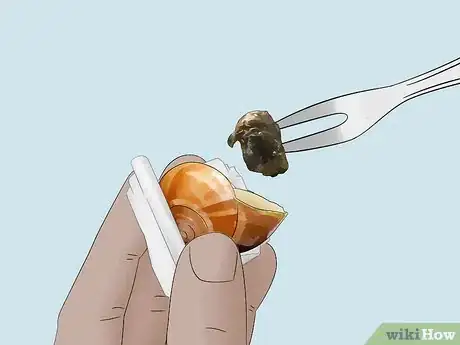This article was co-authored by wikiHow Staff. Our trained team of editors and researchers validate articles for accuracy and comprehensiveness. wikiHow's Content Management Team carefully monitors the work from our editorial staff to ensure that each article is backed by trusted research and meets our high quality standards.
This article has been viewed 95,351 times.
Learn more...
"Escargot" (es-kar-go) is the term used to describe a kind of edible snail often served in drawn butter seasoned with garlic and, potentially, other herbs and spices.[1] Though the practice of eating snails is uncommon in some parts of the world, this food is widely farmed in France and Turkey.[2] If you are expecting to attend a fancy dinner at which escargot is served, or even if you simply want to try the dish yourself, a few simple techniques and adherence to proper etiquette will help you appear like an experienced escargot eater.
Steps
Mastering Traditional Escargot Etiquette
-
1Prepare yourself for the experience. If you are the type that is somewhat squeamish about eating exotic foods, it may help to remind yourself that escargot has long been considered a delicacy. Each snail is prepared according to specific, time tested methods. Edible snails are generally:
- Raised on a rich diet of clean, nutritious food, like cereals, fruits, and leaves.
- Purified before preparation through several days of fasting.
- Fed with flour post-fast to enrich flavor.
- Prepared for consumption.[3]
-
2Familiarize yourself with your tools. When the escargot is served, especially if it is served as an appetizer, you should receive a plate, snail tongs, and snail forks. The plate your escargot will be served on should have several indentations, in which the escargot are placed after cooking.Advertisement
-
3Use a napkin to take hold of your escargot, if necessary. In the event that you are not provided snail tongs, as is the case at some restaurants, you should grasp the escargot by its shell with a napkin.[4] Then hold the shell over your plate and prepare to extract the meat.
-
4Pull the meat free of the shell. Now that you've grasped your escargot with either your snail tongs or your napkin, you should take your snail fork and insert it into the mouth of the shell. You should be able to see a small piece of meat inside the shell.[5] [6]
- Pierce the meat with your fork and pull or twist firmly until you feel the it come loose. Then you should pull the meat from the shell.
-
5Dip your escargot in the sauce provided. Some restaurants may have deeper escargot trays and may have liberally doused the tray with sauce instead of providing you with a separate sauce dish. With the meat still on your fork, dip it into the sauce provided.[7] [8]
- As you eat your escargot, note the similar texture it has to other mollusks, such as clams and mussels.
- Different from sea-dwelling mollusks, snails lack a briny flavor, which allows the herbs and spices used in its preparation to shine through.
-
6
Experimenting with Non-traditional Escargot
-
1Have a broad perspective. You may think that eating snails is strange, you may think of eating snails as highbrow, whichever case, people have been eating snails since the prehistoric era.[11] Over the years and cultures, methods besides the traditional drawn butter, indented plate preparation have come into existence.
- The people of Ghana frequently use young snails in sauces. Larger, fully matured snails are used in soups and for kebabs.
- Nigerian escargot is oftentimes made into a kind of pepper soup.
-
2Search for the right restaurant. If you're ready to move onto a new and possibly more delicious method of snail preparation, you may have to do some research. While snail eating globally is fairly common, you may have to visit a fancy restaurant in your hometown to find the new preparation of escargot that you seek.
-
3Inquire about your prospective escargot dish. Not all species of snail are edible, though this isn't something you should have to worry about if dining at an upscale restaurant. Some species of snail, however, are more suitable for certain dishes or have an uncommon flavor profile. You might ask your server about:
- Why the escargot dish is seasoned the way it is.
- What the natural flavor profile of the escargot snail is.
- Where the snail originates and how it is eaten in its home country.
- If there are suitable wine pairings that would go well with the dish.
-
4Order your new variety of escargot. Some differences will seem slight or may even be unnoticeable to a novice escargot eater. You might have different species of snail to choose from, each of which may have unique flavors, like spicy escargot, or special features, such as above average size. You might also try:
- Escargot prepared on kebab
- Escargot sauces
- Escargot soups
- Grilled escargot
- Fried escargot
-
5Emphasize taste with a suitable wine. The subtle flavors in wine often compliment some kinds of food, and escargot is no different.[12] Keep in mind that the wine most suitable for your particular escargot dish will not only depend on how it is prepared but also your personal palette. Some wines recommended by experts include:
- Pinot noir
- Sauvignon Blanc
- Riesling
- Chardonnay (unoaked recommended)[13]
-
6Sample provided sauces. The chef who created your escargot dish probably did so while paying careful attention to texture and flavor. The sauces provided with your dish are likely intended to bring out these various aspects, creating a more nuanced culinary experience.
Warnings
- Cooked escargot can be hot, watch your tongue.⧼thumbs_response⧽
- Snails are infrequently eaten in some countries. If this is the case for you, you may have an allergy without knowing it. Be careful when eating new foods, especially in foreign places.⧼thumbs_response⧽
References
- ↑ http://www.snail-world.com/snails-as-food/
- ↑ http://www.etiquettescholar.com/dining_etiquette/table_manners/dinner_etiquette/appetizers_and_soup/escargot.html
- ↑ http://www.snail-world.com/snails-as-food/
- ↑ http://www.etiquettescholar.com/dining_etiquette/table_manners/dinner_etiquette/appetizers_and_soup/escargot.html
- ↑ http://www.snail-world.com/snails-as-food/
- ↑ http://www.etiquettescholar.com/dining_etiquette/table_manners/dinner_etiquette/appetizers_and_soup/escargot.html
- ↑ http://www.snail-world.com/snails-as-food/
- ↑ http://www.etiquettescholar.com/dining_etiquette/table_manners/dinner_etiquette/appetizers_and_soup/escargot.html
- ↑ http://www.winedin.com/pair_food_wine.php?food=Escargot
About This Article
Escargot is a kind of edible snail that’s popular in places like France and Turkey. It’s often served in butter with garlic and other herbs and spices. If you’re eating escargot in a restaurant, you’ll usually be given tongs to grip it. But if not, you can grip the shell with a napkin instead. Use your fork to pierce the meat inside and twist it gently to remove it from the shell. Dip it in a sauce if you don’t want to taste just the escargot. It’s also traditional to eat escargot with white wine, which can complement its flavor. You can also get grilled or fried escargot or escargot soup. For more tips, including how to choose a wine to go with your escargot, read on!



































































